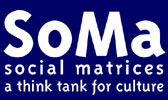
Research
Process
Urban Tapestries is an action research project – blending prototype
development with desk-based and field work. Our approach is not just multidisciplinary,
but transdisciplinary. The project team comprises a range of
skills and backgrounds including filmmaking, sculpture, literature, philosophy,
ethnography, information design, communications, interface design, software
programming and interaction design.
What makes this project different is that the whole core team is involved in decisions and development of each task area – we learn from each other's knowledge and experience not just by observation but by collaborating together. The products of this process range from films, events, ethnographic research, written papers and articles, software design, technical research and development to the development of new models of collaborative working and methodologies, such as the bodystorming experiences. We have found that this combination of skills and techniques blends together to add distinctiveness and freshness to established practices, its creates a powerful group dynamic and energy that supports individual efforts and has enabled a whole field of enquiry to be opened up and explored in a short span of time without sacrificing richness or complexity.
Openness
& Public Debate
Putting
our research into the public domain to stimulate informed debate and to
share insights and revelations with our peers is crucial to our working
process on Urban Tapestries. This can be seen in our events such as the
creative lab and public forum, as well as in our bodystorming experiences
and films. We have also written a number of papers and articles for conferences
and journals. Making all this available to the public via the website
enables us to put our ideas into context and take part in wider debates
with others.
For the public trial we have also developed a new feedback model making use of blogging software to capture and immediately disseminate the experiences of participants. This has enabled instant access to the feedback by peers and public, not least to the participants who were able to read each others comments. They were also able to return and post additional comments after the event. We plan to continue using the blog as a public discussion forum for exploring key issues arising from our research – helping inform and shape our own development.
Project
Management
The project is divided into five main task areas each chaired by a team
member who are reponsible for reporting back to the main project management
committee (made up of the task chairs) on progress. They also lead their
area's development and are responsible for maintaining shared knowledge
resources (such as the the project wiki pages) associated with their task
area.
| Task Area | Chair |
| UT Project Leader | Giles Lane |
| Creative Research & Outcomes | Alice Angus |
| Software Architecture | Daniel Angus |
| Software Development | John Paul Bichard |
| Information Architecture | Nick West |
| Social Research | Roger Silverstone |
Techniques
of Collaboration
Urban Tapestries
focuses on asynchronous human interactions in the urban environment, developing
a layer of wireless communications to support the sharing of 'social knowledge'.
A key aspect of our collaboration has been monthly day-long meetings where
the core team has assembled together to brainstorm and bodystorm key issues
and ideas. An important part of these meetings has been social –
cooking and eating together; taking time out from the 'work' to participate
in a group activity based on community and sharing. Such activities may
seem trivial, but are often a necessary distraction in the process of
overcoming a problem and cohere a group dynamic that is not solely based
on work. Innovation often relies on oblique solutions to problems –
requiring a flexible and fluid structure for creative thinking and reflection.
To support our own collaboration we aslo make extensive use of a Wiki and mailing lists to share information and research findings between remote participants as well as to discuss project development. Proboscis has set up a streaming server (using Apple's open source Quicktime Broadcaster & Darwin Streaming Server) to stream live project meetings to remote participants, and using instant messaging and audio chat as a backchannel. Added to face-to-face meetings, these technologies provide a powerful set of tools to short-circuit distance and physical barriers, as well as supporting an openness of knowledge and information within the group.
